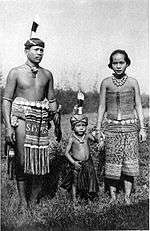Lamandau River
| Lamandau River | |
|---|---|
| Country | Indonesia |
| Basin | |
| Main source | Kalimantan |
| Physical characteristics | |
| Length | 300 km (190 mi) |
Lamandau River (Indonesian: Sungai Lamandau) is a river of Kalimantan, southern-central Borneo, Indonesia.[1] Downstream after passing the village of Nanga Bulik it becomes the Kotawaringin River.[2]
The ancient town of Kotawarinjin is located in the valley formed by the river and its tributary along with gold and gemstone mining areas. In the upper reaches of the tributary valley of Arut River the Panhakalnbun town flourishes on its banks.
Geography
Lamandau River flows through southern Central Kalimantan and Pangkalan Bun, discharging into the Java Sea near Kumai at 2°51′20″S 111°43′14″E / 2.85556°S 111.72056°E. It is a major tributary of Kotawarinjin River, known by this name after its confluence below Naga Bulik village. Tributaries include the Arut River, where in its upper reaches the Panhakalnbun town is located. While the lower reaches of the river are densely populated, the upper reaches have contiguous forest areas where Orangutans can be seen.[2] Kotawarinjin town to the west of the Lamandau River was an ancient capital of a Sultanate.[3]
The catchment of the Lamandau River comprises the western district of KalTeng and Kotawaringin Barat (West-Kotawaringin). Kotawaringin district has a population of 200,000 people constituted by Tuman Dayaks (about 33%) who are Christians. The capital of this district is Panhakalnbun, which has a sub district, a traditional area of the Dolang, close to the Kundangan city where 7000 Dayaks reside in about 100 longhouses spread over 19 villages.[4]
Panhakalnbun town is a waterfront town, which has a plywood manufacturing plant. Its fame is due to the mines nearby where gold and amethyst stones are extracted. In support of these mining activities, several shops selling diesel sets for use in mining have been set up. Another spin-off from the mines is the establishment of a number of gem stores in the town. The particularly popular item of sale is the five set lucky stones of dark coloured amethysts, duly polished and made to shimmer for sale.[5]
People in the valley
The river valley is inhabited by the Dayak peoples, particularly the Tumon in the upper course of the river. The river is popular with tourists who take trips along the rivers by speedboats and traditional klotok boats to visit and experience the lives of the Dayaks. Buddhist influence has also been traced in the Lamandau River valley in the Kotawarinjin town. Buddhist statues with god’s name of Dewata or Mahatara have been found here.[6]
Agriculture
Much of the land between the Jelai-Bila River and the Lamandau River is developed by agriculture.[2]
Lamandau River Wildlife Reserve

The river flows through the 76,000-hectare Lamandau River Wildlife Reserve, in the unique primary forest in Borneo, which has many endangered species, including Bornean orangutans. Human exploitation in the area has led to the pollution of the Lamandau River from gold and zircon mining, illegal logging and large-scale deforestation to create palm oil plantations. However, an awareness campaign has been initiated by NGOs to preserve the Orangutans in the park and also introduce agricultural practices compatible with forest preservation actions.[7]
Within the park, there are two camps namely, the Camp Siswoyo and Camp I, which are maintained by the Orangutan Foundation International (OFI). They are close to Pangkalan Bun and Pasir Pajang, on its eastern border. The infrastructure facilities in these camps have been improved here since September 2003, with funding provided by the Orangutan Foundation, United Kingdom. A guard post has also been established to prevent incursions into the forest or into the river by illegal loggers who had in the past created large-scale destruction of the forests in the region.[8]
See also
References
- ↑ Rand McNally, The New International Atlas, 1993.
- 1 2 3 H. D. Rijksen, E. Meijaard (1999). Our vanishing relative: the status of wild orang-utans at the close of the twentieth century. Springer. pp. 209–210. ISBN 0-7923-5754-X.
- ↑ Dalton, Bill (1992). Indonesia. Passport books. p. 279. ISBN 0-8442-9692-9. Retrieved 2010-11-01.
- ↑ "Travel New asphalt and old totems". Discover Indonesia Online. Retrieved 2010-11-01.
- ↑ Backshall, Stephen (2003). The Rough Guide to Indonesia. The Rough Guide to Indonesia. p. 825. ISBN 1-85828-991-2. Retrieved 2010-11-01.
- ↑ Brown, Alfred Reginald Radcliffe-; Raymond Firth; Adolphus Peter Elkin (1946). Oceania: a journal devoted to the study of the native peoples of Australia, New Guinea, and the islands of the Pacific Ocean, Volumes 16-17. University of Sydney. p. 95. Retrieved 2010-01-01.
- ↑ "Support sustainable forest management in Borneo". National Geographic Global Action Atlas. Retrieved October 30, 2010.
- ↑ "Lamandau Nature Reserve: An Orangutan Release Site". Orangutan Foundation International. Retrieved 2010-11-01.
Coordinates: 2°51′20″S 111°43′14″E / 2.85556°S 111.72056°E

